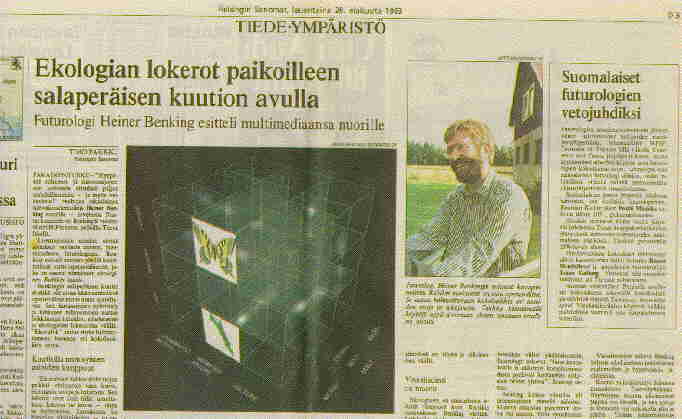Tietotuutti, Knowledge Spiral. 26.8.1993 page 7

Heiner Benking presenting pictures
of the Rubik's Cube of Ecology.
Our view of the world is too flat
says dipl.ing. Heiner Benking and asks if we can change our views-of-life? He has designed the three-dimensional the Rubik's Cube of Ecology. He presented the concept at the Communications Camp to the youngsters and adults, who were listening this well-prepared lecture very carefully. Mr. Benking' presentation main idea was that people should be very curious and interested in many different topics, should try to find connections and similarities in different areas, should know many topics before specialising in some area.
The campers felt very familiar with the idea of the Rubik's Cube even if the cube was concentrated on the ecology. Campers have used the same methods in many camps during the years: every one has learned to know both cooking, interviewing, editing, broadcasting, writing the computers, acting and telecommunicating with all possible equipments, networks and services. It was very interesting pres-.ntation, thank you Heiner Benking and Walter Spielmann from International Futures Library.

"Visualisation of complexity in one simple, comprehensive
concept of indefinite Dimension"
Helsingin Sanomat, the biggest daily in Finland, Aug. 28th, 1993
/ Science and Environment Section
Finn to chair futurists’ organisation
The futurists' world meeting was organised by one of the futures researchers' world organisations, WFSF. Theme of the Turku meeting is Coherence and Chaos, but in practice the themes vary a lot. As an example of this one Swedish futurist had a lecture on avoiding human errors while planning aeroplanes' steering systems.,
Finnish input in WFSF became more Important as Finlands the most famous futurist, member of Club of Rome, Pentti Malaska was elected 105-1 to be the next President of the WFSF.
At least for the next three years the federation will be run from the Finland Futures Research Centre which operates wihin the Turku School of Economics. The centre has operated from the beginning of the 1900’s but it officially starting January 1, 1993.
The most famous guest speakers of the Turku meeting were Benoit Mandelbrot, who has been called as the father of the chaos theory and Norwegian peace activist Johan Galtung. Almost four hundred futures reseachers gathered to Turku last week. Communication camp took part to the Turku meeting by making bilingual newsletters, Tietotuutti, "Knowledge Spiral". Communication comp participants used every possible means of communication from telephones to videos.
(Following is the text as translated from Pentti Malaska’s office)"Ecological Niches Find Their Places
With the Help of the Magic Cube
Futurist Heiner Benking introduced his multimedia to the youth"